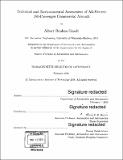Technical and environmental assessment of all-electric 180-passenger commercial aircraft
Author(s)
Gnadt, Albert Reuben.
Download1121197972-MIT.pdf (12.01Mb)
Other Contributors
Massachusetts Institute of Technology. Department of Aeronautics and Astronautics.
Advisor
Steven R. H. Barrett.
Terms of use
Metadata
Show full item recordAbstract
Aviation emissions contribute to climate change, and all-electric aircraft offer an opportunity for zero in-flight emissions. Over the past decade, more than 50 all-electric conceptual, experimental, and commercial aircraft have been researched, with a particular focus on light aircraft. These designs are reviewed, along with progress in battery technology. An all-electric aircraft design and optimization program, TASOPTe, has been developed from an existing version for conventionally-powered aircraft, TASOPT. Both programs are largely based on first-principles, enabling the design of aircraft with unusually short design ranges. A series of optimized 180-passenger aircraft based on the Airbus A320neo configuration are designed and evaluated at 200-1600 nmi design ranges with 2-10 propulsors and 400-2000 Wh/kg batteries. The performance of these all-electric aircraft is compared to advanced conventionally-powered aircraft optimized for the same design ranges. Optimized all-electric aircraft are found to use two or four propulsors, depending on the design range and specific energy assumed. The design range limits for each specific energy are determined, which are restricted by aircraft weight and performance penalties. A factor of four increase in battery pack specific energy from current values of 200 Wh/kg to 800 Wh/kg enables 500 nmi flights. However, a lower design range of 300 nmi provides improved energy and environmental performance. The required grid power generation circumstances for commercial all-electric aircraft to become net environmentally beneficial is determined for each specific energy assumption. The entire energy conversion chain, including charging, transport, and discharging of electrical energy, is considered. Despite the higher total energy use, narrow-body all-electric aircraft have the potential for lower equivalent CO₂ emissions if the electrical grid transitions toward renewable energy. This is largely enabled by the complete elimination of all high-altitude emissions, which would remove associated non-CO₂ warming.
Description
Thesis: S.M., Massachusetts Institute of Technology, Department of Aeronautics and Astronautics, 2018 Cataloged from PDF version of thesis. Includes bibliographical references (pages 85-99).
Date issued
2018Department
Massachusetts Institute of Technology. Department of Aeronautics and AstronauticsPublisher
Massachusetts Institute of Technology
Keywords
Aeronautics and Astronautics.